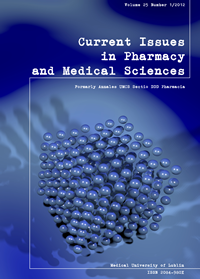The influence of selected variables on the values of systolic pressure in patients with hypertension
DOI:
https://doi.org/10.12923/j.2084-980X/25.1/a.24Słowa kluczowe:
arterial hypertension, systolic pressure, BMI, physical activity, smokingAbstrakt
Hypertension is a disease of the first world and results to a great extent from leading an improper lifestyle. Some important risk factors include being overweight or obese, indulging in little physical activity, smoking and abusing alcohol. The aim of this study was to analyze the influence of some selected variables, including lifestyle choices, on systolic blood pressure in patients treated for hypertension. The study was conducted among 132 patients using the medical services in five randomly selected clinics in Lublin. The influence of age, sex, body mass index, physical activity and smoking on systolic blood pressure was analyzed. The study shows that systolic blood pressure depends on the selected variables. In general, however, a positive correlation was found between age and systolic blood pressure, regardless of gender. Moreover, a higher systolic blood pressure was also observed in men, as well as in individuals with low physical activity, in those who smoke and those who are overweight or obese. Our results indicate that patients with hypertension should be aware that drug therapy and lifestyle are integral components of disease treatment, and modification of their lifestyles towards leading healthy ones is a necessity.
Bibliografia
1. Bartczuk A. et al.: Zmiana stylu życia w nadciśnieniu tętniczym – rola warsztatów edukacyjnych dla pacjentów i ich rodzin. Annales UMCS, sect. D, VOL LX, SUPPL. XVI, 21, 82, 2006.
2. Chmiel-Połeć Z. and Cybulska I.: Palenie papierosów i występowanie podwyższonych wartości ciśnienia tętniczego krwi wśród młodzieży ponadgimnazjalnej. In: Wdowiak, L, W. Kruk and M. Bińkowska-Bury (editors): Public Health and Research. Lublin: Neurocentrum; p. 69. 2009.
3. Chmiel-Połeć Z. and Cybulska I.: Uwarunkowania genetyczne oraz wzrost BMI, jako czynniki predysponujące do podwyższonych wartości ciśnienia tętniczego krwi wśród młodzieży In: Wdowiak, L, W. Kruk and M. Bińkowska-Bury (editors): Public Health and Research. Lublin: Neurocentum; p. 85. 2009.
4. Januszewicz A. (editor): Nadciśnienie tętnicze. Zarys patogenezy, diagnostyki i leczenia. Kraków: Medycyna Praktyczna. 2002.
5. Januszewicz A., Januszewicz W., Szczepańska-Sadowska E. and Sznajderman M. (editors): Nadciśnienie tętnicze. Kraków: Medycyna Praktyczna. 2004.
6. Kawecka-Jaszcz K., Pośnik-Urbańska A. and Jankowski P.: Rozpowszechnienie nadciśnienia tętniczego w zależności od płci w świetle badań epidemiologicznych w Polsce. Nadciśnienie Tętnicze, 11, 377, 2007.
7. Krzysztoń J., Windak A., Cwynar M. and Grodzicki T.: Wpływ podstawowych cech demograficznych i antropometrycznych na parametry obwodowego i centralnego ciśnienia tętniczego. Nadciśnienie Tętnicze, 14, 253, 2010.
8. Lewington S., Clarke R. and Qizilbash N.: Age-specific relevance of usual blood pressure to vascular mortality: a meta-analysis of individual data for one million adults in 61 prospective studies. Lancet, 360, 1903, 2002.
9. MacMahon S., Peto R. and Cutler J.: Blood pressure, stroke, and coronary heart disease. Part 1. Prolonged differences in blood pressure: prospective observational studies corrected for the regression dilution bias. Lancet, 335, 765, 1990.
10. Pieniążek M. and Wierzbicka A.: Styl życia pacjentów a czynniki ryzyka nadciśnienia tętniczego. Annales UMCS, SECTIO D, Vol. LX, SUPPL. XVI, 594, 69, 2006.
11. Whelton S.P., Chin A., Xin X. and He J.: The effect of aerobic exercise on blood pressure: a meta-analysis of randomized, controlled trials. Ann. Intern. Med., 136, 493, 2002.
Pobrania
Opublikowane
Numer
Dział
Licencja
Prawa autorskie (c) 2012 Autorzy

Praca jest udostępniana na licencji Creative Commons Attribution-NonCommercial-NoDerivatives 3.0 Unported License.


